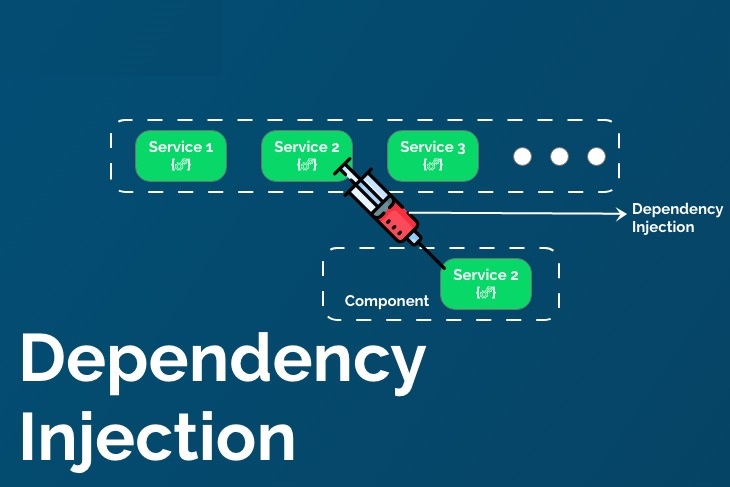Dependency injection (DI) is a software design pattern that enhances code flexibility, maintainability, and testability by managing the dependencies of objects. Instead of an object creating its own dependencies, they are provided (or “injected”) from an external source. This design pattern promotes loose coupling, making your code easier to modify, extend, and test. In this article, we’ll explore what dependency injection is, its benefits, different types, and how to implement it in your code.
1. What Is Dependency Injection? 🤔
In object-oriented programming, classes often rely on other classes to perform their functions. These external classes are called dependencies. Traditionally, a class might create its dependencies directly within its constructor or methods. However, this approach tightly couples the classes, making the code difficult to maintain and test.
Dependency Injection solves this problem by providing an object’s dependencies from the outside rather than creating them internally. This external provisioning decouples the classes, making the system more modular and easier to manage.
Example (Without Dependency Injection):
python
-----
class Engine:
def start(self):
return "Engine started!"
class Car:
def __init__(self):
self.engine = Engine() # Direct dependency creation
def drive(self):
return self.engine.start()
car = Car()
print(car.drive()) # Output: Engine started!
In this example, Car is tightly coupled to Engine because it directly creates an instance of Engine. If we need to change or mock the engine, we must modify the Car class, violating the Open/Closed Principle.
Example (With Dependency Injection):
python
-----
class Engine:
def start(self):
return "Engine started!"
class Car:
def __init__(self, engine: Engine): # Dependency injection
self.engine = engine
def drive(self):
return self.engine.start()
engine = Engine()
car = Car(engine) # Injecting the dependency
print(car.drive()) # Output: Engine started!
Here, the Car class receives its Engine dependency externally, making it more flexible and easier to test.
2. Benefits of Dependency Injection ✅
A. Loose Coupling 🔗
DI reduces the tight coupling between classes. Since objects do not create their dependencies, they depend on interfaces or abstractions rather than concrete implementations. This makes it easier to modify or replace dependencies without affecting the dependent classes.
B. Improved Testability 🧪
By injecting dependencies, you can easily replace real objects with mocks or stubs during unit testing. This allows for more isolated and reliable tests.
Example (Testing With Mock):
python
-----
from unittest.mock import Mock
class Engine:
def start(self):
return "Engine started!"
class Car:
def __init__(self, engine):
self.engine = engine
def drive(self):
return self.engine.start()
# Testing
mock_engine = Mock()
mock_engine.start.return_value = "Mock engine started!"
car = Car(mock_engine)
print(car.drive()) # Output: Mock engine started!
C. Enhanced Maintainability 🛠️
DI makes code easier to maintain and extend. When dependencies are injected, updating or replacing them does not require modifying the classes that use them. This follows the Open/Closed Principle of SOLID design principles.
D. Simplified Code Reuse ♻️
Since dependencies are not hardcoded within classes, components are more reusable across different parts of the application.
E. Scalability and Flexibility 🚀
DI simplifies scaling large applications by managing dependencies in a centralized manner, often through a dependency injection container.
3. Types of Dependency Injection 🗂️
There are three main types of dependency injection, each with its specific use cases:
A. Constructor Injection 🏗️
Dependencies are provided through the class constructor. This is the most common and preferred method because it ensures that a class is always initialized with its required dependencies.
python
-----
class Engine:
def start(self):
return "Engine started!"
class Car:
def __init__(self, engine: Engine):
self.engine = engine
def drive(self):
return self.engine.start()
engine = Engine()
car = Car(engine) # Injecting dependency via constructor
print(car.drive())
B. Setter Injection 🛠️
Dependencies are provided through setter methods after the object is created. This method is useful when dependencies are optional or can change during the object’s lifecycle.
python
-----
class Engine:
def start(self):
return "Engine started!"
class Car:
def __init__(self):
self.engine = None
def set_engine(self, engine: Engine):
self.engine = engine
def drive(self):
return self.engine.start()
car = Car()
car.set_engine(Engine()) # Injecting dependency via setter
print(car.drive())
C. Method Injection 💉
Dependencies are passed directly to the methods that require them. This approach is suitable when dependencies are only needed temporarily within a specific method.
python
-----
class Engine:
def start(self):
return "Engine started!"
class Car:
def drive(self, engine: Engine):
return engine.start()
engine = Engine()
car = Car()
print(car.drive(engine)) # Injecting dependency via method
4. Dependency Injection Containers 📦
In larger applications, manually injecting dependencies can become cumbersome. A Dependency Injection Container (DIC) automates the process by managing object creation and injecting dependencies where needed. Containers help with:
- Centralized configuration of dependencies
- Managing the lifecycle and scope of dependencies
- Simplifying dependency resolution for complex applications
Example Using a DI Container in Python:
python
-----
from dependency_injector import containers, providers
class Engine:
def start(self):
return "Engine started!"
class Car:
def __init__(self, engine: Engine):
self.engine = engine
def drive(self):
return self.engine.start()
# Dependency Injection Container
class Container(containers.DeclarativeContainer):
engine = providers.Singleton(Engine)
car = providers.Factory(Car, engine=engine)
container = Container()
car = container.car() # Container automatically injects the engine
print(car.drive()) # Output: Engine started!
Using containers improves code organization, simplifies dependency management, and enhances scalability, especially in large systems.
5. Dependency Injection in Different Programming Languages 🌍
Dependency injection is widely used across various programming languages, each with its frameworks and libraries:
- Python:
dependency-injector,injector - Java: Spring Framework, Google Guice
- C#: .NET Core’s built-in DI container, Autofac, Unity
- JavaScript/TypeScript: Angular’s DI system, InversifyJS
- PHP: Laravel’s service container, Symfony’s DI component
6. Common Mistakes and How to Avoid Them ⚠️
- Overusing Dependency Injection: Not every class needs DI. Use it where it provides clear benefits in flexibility and testability.
- Complex Dependency Graphs: Too many nested dependencies can make the system hard to understand and maintain. Use DI containers to manage complexity.
- Injecting Too Many Dependencies: Avoid injecting too many dependencies into a single class, as it violates the Single Responsibility Principle (SRP).
- Mixing Dependency Injection Methods: Be consistent with your approach—prefer constructor injection for mandatory dependencies and setter or method injection for optional ones.
- Ignoring Dependency Lifetime: Manage the lifecycle of dependencies correctly (singleton, transient, or scoped) to avoid memory leaks or unintended behavior.
7. Real-World Applications of Dependency Injection 🌍
- Web Development: Frameworks like Spring (Java) and ASP.NET Core (C#) use DI to manage controllers, services, and middleware, improving modularity and testability.
- Microservices Architecture: DI simplifies service interactions, making microservices more independent and easier to maintain.
- IoT Systems: Injecting hardware interfaces allows flexible and scalable IoT applications.
- Game Development: DI facilitates modular game design, allowing components like AI, physics, and rendering to be easily replaced or extended.
8. Conclusion ✅
Dependency injection is a powerful design pattern that promotes loose coupling, improves testability, and enhances code maintainability. By providing dependencies externally rather than creating them internally, DI makes your code more modular, flexible, and easier to maintain. Whether using constructor, setter, or method injection, applying DI correctly leads to cleaner, more efficient code. As your applications grow in complexity, leveraging DI containers can further streamline dependency management, making your codebase more scalable and maintainable.


